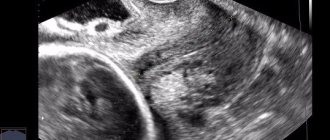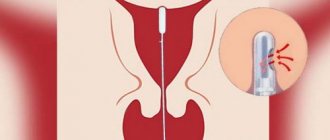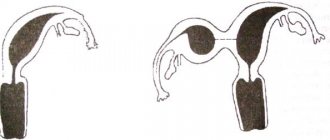Technique
The operation is performed exclusively in a hospital setting. The operation is painful because the process removes the surface layer of the uterine lining. Therefore, when performing it, anesthesia is required.
Cleaning is usually carried out from 5 to 12 weeks of pregnancy.
Women at risk for frozen pregnancy include:
- over 30 years old;
- who have already had a similar case of pregnancy;
- have had more than one abortion;
- with uterine abnormalities;
- with diseases of the endocrine system;
- recovered from sexually transmitted infections.
The reasons for this pathology can be very different, from hormonal disorders to excessive physical exertion. But if pregnancy fading has already occurred, then the fetus must be extracted in any case.
Symptoms
Symptoms during a non-developing pregnancy can be either pronounced or not. A woman who has been tormented by toxicosis may notice that it has suddenly disappeared. The mammary glands become softer, they no longer have the same tension as before. Upon examination, the doctor notices that the uterus has stopped enlarging, although before that its growth was rapid.
If at the beginning of pregnancy the temperature rises slightly and remains in this state for a long time, then when it freezes the temperature becomes lower than normal. In addition, the woman feels severe weakness and deterioration. She gets chills. If severe abdominal pain appears, this is the beginning of fetal rejection.
During the second trimester, a non-developing pregnancy is determined by the absence of fetal movement. The fetus moves a lot from the very beginning, but if there is no movement, then it is already dead. It is also determined by the cessation of heartbeat.
However, there are cases when a non-developing pregnancy does not make itself felt. Then the woman suspects nothing about her condition, increasingly leading to a serious problem. After all, after death, the fetus begins to infect not only the uterus, but also the entire body, which entails a threat to the life and health of the woman. If a woman visits the doctor constantly, then this will not happen.
Preparing for surgery
Vacuum cleaning of the uterus during a frozen pregnancy is carried out on an empty stomach, after at least eight hours of fasting. Before the operation, the woman is examined by a gynecologist to make sure there are no possible contraindications, and by an anesthesiologist to determine the anesthesia.
After examining the patient, doctors decide to perform surgery. In cases of detection of genital infections, inflammation of the pelvic organs, or damage to the uterine mucosa, the cleansing will have to be canceled.
Before the operation, the woman will have to pass:
- blood and urine tests;
- hCG level study;
- smear to detect infections;
- blood test for group and Rh factor;
- bacteriological culture;
- blood to determine coagulability (coagulogram);
- ECG.
After the studies, the patient must sign consent for the operation.
Two weeks before the cleansing, the woman should stop taking all medications that may affect blood clotting. If the operation is planned for the near future, then at least 2 days before it you need to:
- avoid using intimate hygiene products;
- suspend sexual activity;
- stop douching;
- stop using medications.
Recovery
What not to do after the procedure, as well as possible complications:
You cannot have sexual intercourse with a man for at least a month after the procedure. This is necessary to ensure that no infection gets inside the uterus, and also to avoid injuring the cervix.
You should not subject your body to physical stress. This point includes not only sports and fitness, but even lifting weights while doing household chores. During physical activity, blood rushes to the legs, as well as to the genitals. Because of this, bleeding or longer healing of the uterus is possible.
You cannot go to the sauna, swimming pool or just take a bath. This should also be avoided for at least a month. There may be infections in the water that can easily enter the slightly dilated cervix. After this procedure, you only need to take a shower.
You should not go to the bathhouse because it overheats the whole body. As a result, uterine bleeding and inflammation occur. Personal hygiene should not be neglected. Every day you need to wash yourself. This is necessary to prevent bacteria from developing in the vagina, which then easily penetrate the uterus.
If the doctor was experienced and the woman followed all the recommendations, then in this case there will be no complications. But if the doctor did the vacuum aspiration incorrectly, then this can even lead to complete infertility. In addition, a woman should take all medications prescribed by her doctor. If she does not do this, then there is a high probability of hormonal disorders and inflammatory diseases, which in the future can cause infertility.
Thus, the introduction of objects into the uterine cavity very often ends in endometritis, since pathogenic microorganisms penetrate from the vagina onto the sterile mucous membrane of the uterus. To prevent inflammation, antibiotics are prescribed. It is not worth refusing to take the drug prophylactically; the risk of developing endometritis is very high.
Operation
Vacuum cleaning of the uterus during a frozen pregnancy can be carried out using two methods:
- Manual. This technique uses a syringe, which the doctor uses to suck out the contents of the uterus.
- Machine. To carry out this operation, a special pump is used.
In both types of procedures, the woman is given anesthesia, after which the genitals are treated with an antiseptic. The doctor then inserts a speculum into the vagina and, if necessary, administers a second injection of anesthesia into the cervix.
Using a special device, the distance to the uterus is measured. If the cervix is not dilated enough, a dilator is used. Only after this is a tube inserted, which sucks in tissue and cleanses the uterine cavity. Then the patient is injected with drugs that shrink the endometrium. The duration of the entire procedure does not exceed 15 minutes.
As a rule, doctors prefer general anesthesia, because with it the patient will not feel anything.
But the disadvantage of such anesthesia is the long recovery from it (at least 2 hours).
After vacuum cleaning, the embryo is sent for research to determine the causes of pregnancy failure.
Causes
There are many reasons for a pregnancy not developing. There can be several of them at the same time. In some cases, even an experienced doctor does not determine the true cause. Below are the main ones:
- Infection or inflammatory process.
Any infection can easily reach a child, even if the mother has recently become infected with it. The most dangerous diseases are: rubella, herpes or toxoplasmosis. With them, pregnancy ends in miscarriage in almost 100% of cases. Infections that are sexually transmitted have an adverse effect. These include chlamydia, gonorrhea, HIV and others.
Moreover, even the slightest cold provokes the death of the fetus. Moreover, it makes no difference whether the infection was before or during pregnancy. A woman should try not to get sick for a long time before pregnancy.
During infection, the connection between the fallopian tube and the embryo itself is damaged. If the infection entered the body in the early stages, then there is a high probability of fetal death, and if it entered the body later, then the child may have developmental abnormalities and some diseases at birth.
- Chromosome-related disorders.
During normal fertilization, an egg should receive 23 chromosomes from each parent. However, there are cases when there are more chromosomes. In this case, a violation of the development of the fetus occurs, defects occur that are not compatible with life.
This situation is planned by the woman’s body, since it is inherent in nature that only the strongest and most complete embryo should survive. If he is not what he should be, then he is rejected.
- Hormonal dysfunction.
During pregnancy, a woman's hormonal levels must be in a certain balance. If hormonal fluctuations occur, then the child cannot develop normally, which means a non-developing pregnancy occurs.
- Autoimmune disorder.
If the child and mother have an incompatible Rh factor, then the female body tries to reject the foreign object. If this succeeds, then the pregnancy stops. If not, then there is a threat to the further development of the child, as well as the life of the mother.
- Endometrial disorder.
With frequent abortions, the endometrium cannot function as before. Because of this, the embryo does not have the opportunity to properly consolidate and receive the necessary nutrition. A woman’s lifestyle, the surrounding ecological situation.
If a woman has bad habits and, moreover, lives in a city with dirty air, then the child in some cases stops developing because he lacks nutrition and oxygen. He is only poisoned by various harmful things.
- Weak immune system.
If a woman has any immunity disorders, then it is not easy for her to fight viruses and bacteria. With reduced immunity, a woman feels unwell.
Why is vacuum cleaning used?
For whatever reason, a frozen pregnancy occurs, the uterus needs timely cleaning. Otherwise, sepsis may develop or the process of intoxication will begin.
Vacuum cleaning of the uterus during a frozen pregnancy is the best option. It is carried out under the supervision of a doctor who controls the process and makes sure that no parts of the embryo remain in the uterine cavity.
Another type of cleaning is scraping. To carry it out, a curette is used, with which the doctor scrapes off the fertilized egg. When curettage, it is necessary to undergo general anesthesia, since the procedure is considered very painful. After the operation, the woman recovers from anesthesia within several hours.
In the case of curettage, complications may arise in the form of remnants of fetal parts or perforation of the uterine wall. And then in any case you will have to carry out vacuum cleaning.
Postoperative period
After vacuum cleaning, a woman should monitor her health in order to promptly notice suspicious symptoms of such consequences of the operation as:
- excessive bleeding with possible unpleasant odor. To prevent complications and notice this symptom in time, you need to temporarily stop using tampons and give preference to pads;
- inflammation resulting from incomplete extraction of the embryo or due to damage to the walls of the uterus at the time of curettage;
- cramps in the lower abdomen. Painkillers will help muffle these symptoms;
- adhesions;
- perforation of the uterine wall. This postoperative complication requires immediate surgical intervention. Most often it occurs as a result of curettage.
After surgery, there may be weakening of the cervix, infection due to the patient's lack of hygiene, hormonal imbalances, uterine bleeding (as a result of damage to fibroids), or damage to the cervix with an instrument. The work of an inexperienced doctor can also lead to adverse consequences. But it is important to remember that a frozen pregnancy that is not detected and treated in time can cause much more dangerous complications.
Body temperature in the first few days after surgery may be slightly elevated, but not more than 37.5. If this condition lasts more than 3 days or the temperature begins to rise, you should inform your doctor as soon as possible.
Menstruation after the operation decreases, after 7 days it becomes more scanty and spotty. Cleaning the uterus also affects the regularity of the cycle; the delay at first can be 2-3 months. But if such changes occur, you should definitely see a doctor.
After curettage or vacuum cleaning for 14 days, a woman should regularly monitor her body temperature and discharge.
After this period, it is necessary to undergo an ultrasound examination of the uterus to determine the presence of parts of the fertilized egg. The complex of postoperative procedures also includes blood tests for hormone levels, a vaginal smear, and histology of the uterine epithelium. If necessary, a woman should visit a psychotherapist who will help her cope with depression.
During the entire rehabilitation period, a woman should take vitamins, antibiotics recommended by a doctor to prevent inflammatory processes, and hormonal medications. You will have to stop having sex for a month. It’s better to continue it only after the end of the first menstruation
You can plan a new pregnancy after curettage or vacuum cleaning only after six months. Otherwise, history may repeat itself.
If it happens that pregnancy occurs before the expiration of the prophylactic period, then the main task of doctors will be to preserve it. Since any abortion in the early stages can become a serious cause of further miscarriage, as well as cause serious trauma to the woman’s psyche.
Complications
If curettage is carried out by an experienced and qualified specialist, then complications are quite rare, but possible. What pathology can develop after aspiration and curettage:
- Perforation of the uterus (puncture) as a result of mechanical curettage. Reasons: technical difficulties in dilating the organ, excess pressure, loose or altered uterine wall. Minor perforations heal spontaneously, and if larger injuries occur, surgical intervention and suturing are performed.
- Tear of the uterine wall. It can happen during the procedure when the clamps for fixing the cervix come off. Small injuries heal on their own, but if they are extensive, suturing is required.
- Violation of septic and antiseptic conditions, lack of supportive antibacterial treatment can lead to inflammation of the uterus.
- An adhesive process with the formation of synechiae - connective tissue growths that disrupt the menstrual and generative (formative) function of the ovaries.
- Heavy bleeding. The uterus has an intensive blood supply and the risk of this complication is quite high. The situation will worsen if the woman suffers from a bleeding disorder. This is a dangerous condition that requires immediate hospitalization.
- Hematometra is an accumulation of blood during a spasmodic cervix.
- An allergic reaction to drugs that were used for anesthesia.
If the procedure is performed by a doctor with insufficient experience and technique, his strong and aggressive actions can lead to injury to the germ cells that cover the mucous membrane. With damage, the growth of new tissue becomes impossible. After curettage for endometriosis, with excessive cleaning of the mucous membrane, the incurable disease adenomyosis often develops - a complete cessation of growth or active uncontrolled growth of the base layer of connective tissue.










